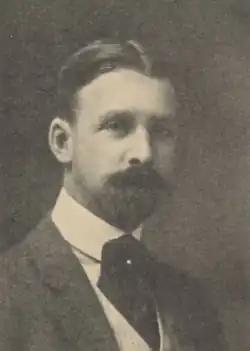John Almy Tompkins II
John Almy Tompkins II | |
|---|---|
 | |
| Born | 1871 Baltimore, Maryland, U.S. |
| Died | May 21, 1941 (aged 69) Forest Hills, New York, U.S. |
| Nationality | American |
| Alma mater | Columbia University School of Architecture |
| Occupation | architect |
John Almy Tompkins II (1871 – May 21, 1941) was an American architect.
Early life and education
Tompkins was born in 1871 in Baltimore, Maryland to Brevet Brigadier General Charles Henry Tompkins Sr. and Jane Carr Tompkins.[1] His father was a Brevet Brigadier General and Colonel for the Union Army from Rhode Island during the American Civil War. His uncle, John Almy Tompkins was a Lieutenant Colonel for the Union Army during the Civil War as well.
Tompkins attended St. Paul's School in Concord, New Hampshire from 1883 to 1889.[2] He then attended the Columbia Graduate School of Architecture, Planning and Preservation.[1]
Career
His architectural career began in 1894 upon completed of Columbia School of Architecture.[2]
He began the design of the St. Andrews Episcopal Church in New London, New Hampshire in 1905, and completed it in 1909, built in the Gothic architecture style.[3] Tompkins, along with Grosvenor Atterbury, was given the commission for the model housing community of Forest Hills Gardens which began in 1909 under the sponsorship of the Russell Sage Foundation.[4] He worked closely with Grosvenor Atterbury[5] until his retirement in 1937 due to poor health.[1]
In 1912, the Russell Sage Foundation then commissioned them to build their headquarters and annex, which building was completed in 1913.[6] The New York Landmarks Preservation Commission deemed the building a historic landmark on April 25, 2000. In 1915, they completed work on The Church-in-the-Gardens of the Forest Hills housing community.[7] On December 11, 2009, the National Register of Historic Places of the United States Department of the Interior placed the building into the national register due to its cultural and architectural significance in New York City.[8] His work was published in the 1910 edition of The Architectural Review for his design of a lake house at Sebago Lake in Maine.[9]
In 1920 (completed in 1924), they designed the buildings on Surprise Hills Farm (Swiss Village) on Beacon Hill Road, and is now part of Edgehill Farm, in Newport, Rhode Island, inspired by the rural vernacular architecture of Southern France and Northern Italy. The farm buildings are now part
He was a member of the American Institute of Architects (AIA) since 1911 and a Fellow of the American Institute of Architects (FAIA) since 1930.[10][11]
Works
- American Wing of the Metropolitan Museum of Art.[12]
- Russell Sage Foundation Building.[6]
- West Side Tennis Club.[13]
- Restoration of New York City Hall.[12]
- Phipps Model Apartments.[12]
- St. Andrews Episcopal Church in New London, New Hampshire.[3]
- Housing community center of Forest Hills, Long Island, through the Russell Sage Foundation.[4]
- The Church-in-the-Gardens of Forest Hills, through the Russell Sage Foundation.[7]
Personal life
He died on May 21, 1941 in Forest Hills, New York.[1][14]
References
- ^ a b c d "JOHN ALMY TOMPKINS 2D; Architect, Sage Foundation Aide, Aotive in Queens Development". The New York Times. 1941-05-23. ISSN 0362-4331. Retrieved 2025-05-19.
- ^ a b "Ohrstrom Library Digital Archives » Blog Archive » First Halcyon 1889". Retrieved 2025-05-19.
- ^ a b "Architecture". St. Andrew's. Retrieved 2025-05-19.
- ^ a b "John Almy Tompkins". digital.library.cornell.edu. Retrieved 2025-05-19.
- ^ Pennoyer, Peter; Walker, Anne (August 2009). The Architecture of Grosvenor Atterbury. W. W. Norton & Company. ISBN 978-0-393-73222-1.
- ^ a b "Russell Sage Foundation Building and Annex" (PDF). New York Land Preservation Commission.
- ^ a b sources), FHG Foundation (posted from other (2021-03-25). "Building The Church-In-The-Gardens". Forest Hills Gardens Foundation. Retrieved 2025-05-19.
- ^ "The Church-In-The-Gardens". National Register of Historic Places.
- ^ Koch, Alex (1910). "House for HM Verrill, Esq., Sebago Lake, Maine" (PDF). Academy Architecture and Architectural Review. 37: 123.
- ^ "John Almy Tompkins Ⅱ, Architect". ArchInform.
- ^ "ahd1045204 - AIA Historical Directory of American Architects - Confluence". aiahistoricaldirectory.atlassian.net. Retrieved 2025-05-19.
- ^ a b c Dictionnaire des élèves architectes de l’École des beaux-arts de Paris (1800-1968); AGORHA - Bases de données de l'Institut national d'histoire de l'art; Paris (1800-1968), Dictionnaire des élèves architectes de l’École des beaux-arts de; l'art, Institut national d'histoire de (2025-01-15). Atterbury, Grosvenor.
{{cite book}}: CS1 maint: numeric names: authors list (link) - ^ Rego-forester (2010-09-17). "Rego-Forest Preservation Council: Landmark Support Letter from Peter Pennoyer Architects & Forest Hills Tennis Stadium's Placement In Literature". Rego-Forest Preservation Council. Retrieved 2025-05-19.
- ^ Shettleworth, Earle. "Brief biographies of American architects who died between 1897 and 1947" (PDF).